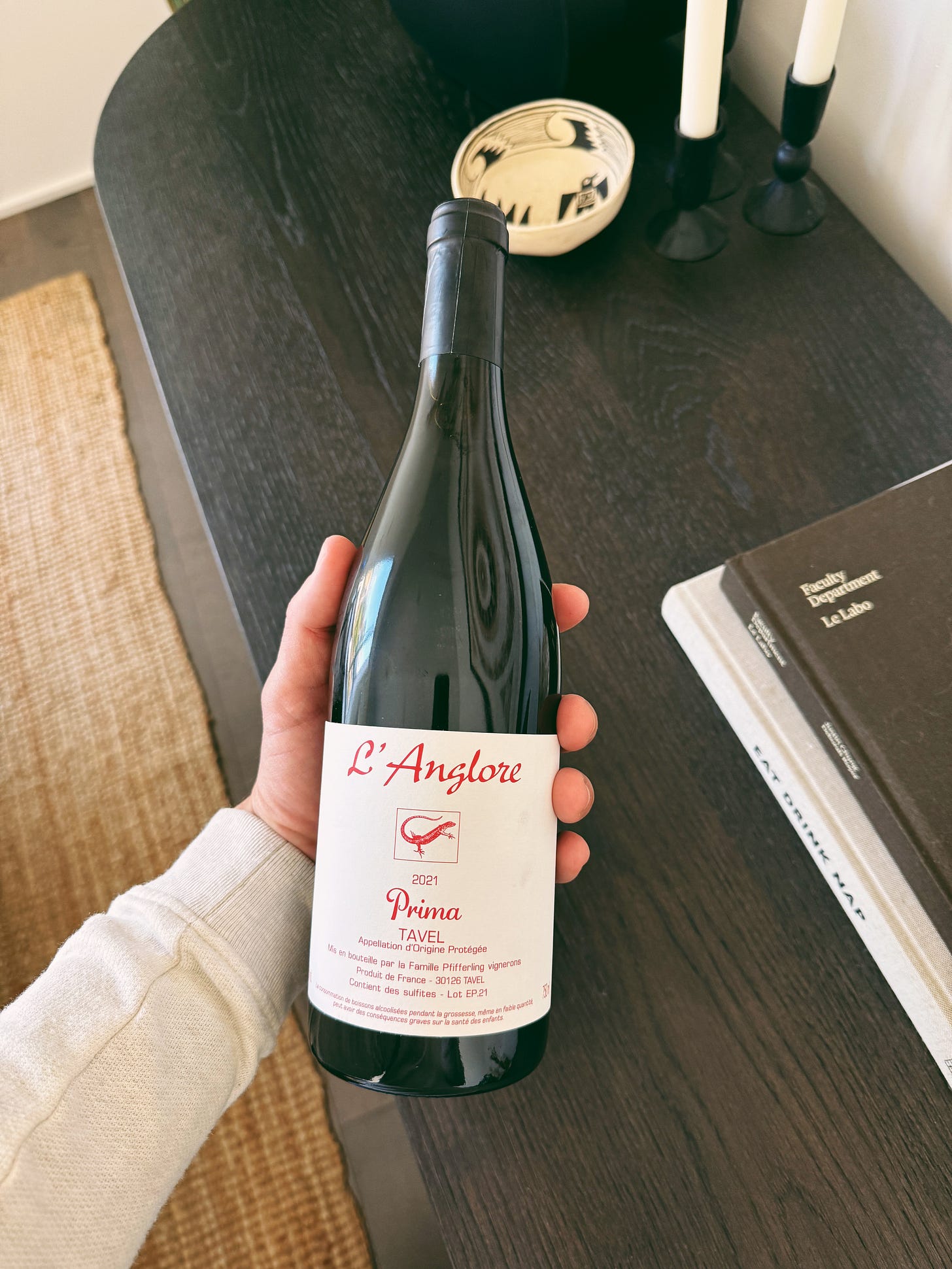I’m unashamed to admit it: I love rosé. Always have. Give me a bottle, a sun-drenched afternoon, and zero responsibilities, and I’m a happy camper. It’s simple, it’s unfussy, and it asks for nothing but a cold glass and a good time. There’s a reason you can drink it poolside without judgment—rosé is the great equalizer of wine. No pretense, no ceremony, just something cool, crisp, and completely unbothered. And in the dead heat of summer, when even the thought of turning on an oven feels like punishment, there’s nothing better.
But here’s the thing: it’s not summer.
Right now, the Northern Hemisphere is firmly in the clutches of winter. It’s stew season. Red wine season. The time of year when a pale, delicate rosé feels about as useful as a paper umbrella in a thunderstorm. And yet, I just drank a rosé that didn’t just work in winter—it thrived in it.
Enter Tavel.
Tavel is what happens when rosé decides it’s done being delicate. It’s got guts. It’s structured, it’s deep, it’s unapologetically bold. If your usual rosé is a whisper, Tavel is a damn shout. This isn’t some fleeting, fruit-forward pink drink—it’s a Rhône Valley heavyweight with a history that goes back centuries, loved by popes, kings, and people who don’t have time for nonsense.
And if you’ve never had it, you’ve been missing out.
A Tiny Powerhouse with a Royal Pedigree
Tavel isn’t just any rosé—it’s the pioneer. The only AOC (Appellation d'Origine Contrôlée, or official appellation—not to be confused with the politician) in France that produces exclusively rosé, Tavel has been doing things its own way for centuries. This tiny region, tucked into the Southern Rhône Valley just west of Châteauneuf-du-Pape, is barely a blip on the wine map. We’re talking super small production—about 1,000 hectares, a fraction of what Provence churns out. Blink, and you might miss it. But what Tavel lacks in size, it more than makes up for in attitude.
This is a wine with history, clout, and a serious chip on its shoulder. Back in the 14th century, when the Popes were holding court in Avignon (about 10 miles away), Tavel was already making waves. It was a favorite of Pope Innocent VI, who, like any self-respecting medieval leader, understood the importance of good wine. The French aristocracy caught on, and soon, Tavel was crowned the “rosé of kings.”
Even literary heavyweights like Balzac and Hemingway sang its praises. When Hemingway wasn’t busy hunting in Spain or slamming daiquiris in Havana, he was reportedly sipping Tavel—a rosé with enough backbone to match the man’s infamous appetite for excess.
But despite its regal and literary pedigree, Tavel never went mainstream. It doesn’t fit into the crisp, delicate rosé mold that Provence has turned into a global cash cow. It refuses to be pale, refuses to be light, and refuses to be typecast as a "summer wine." Tavel is darker, richer, and built to last—rosé with a rebellious streak.
Why Tavel is Different from Other Rosés
Most rosé is made to be drunk young—fresh, fruity, and forgettable after a year or two. That’s not how Tavel rolls.
Aging Potential: Unlike Provence rosés, which lose their vibrancy after a year or two, Tavel can age for 5–10 years. As it matures, the bright red fruit deepens into dried cherry, blood orange, and warm spice, and the herbal notes become more pronounced—like a walk through sun-dried Mediterranean scrubland.
More Depth, More Structure: Tavel ferments with more skin contact than most rosés, meaning the juice spends extra time with the grape skins, extracting more color, texture, and tannin—that’s what gives it a bolder mouthfeel and a hint of grip. If a Provence rosé is a silk scarf, Tavel is a well-worn leather jacket.
Darker, Richer, More Intense: The extra contact with the skins also explains why Tavel isn’t pale pink—it ranges from deep salmon to ruby red.
What’s in the Bottle? The Grapes of Tavel
Tavel isn’t a one-note wine—it’s a blend, carefully crafted to deliver structure, complexity, and balance. The main grape here is Grenache, the backbone of many Rhône wines, bringing ripe red fruit, body, and warmth. But Tavel doesn’t stop there. Other varieties play a crucial role in shaping its bold personality:
Cinsault – Adds fresh acidity and bright red berry notes. Keeps the wine from feeling too heavy.
Syrah & Mourvèdre – These two bring depth, spice, and just a hint of tannic grip, making Tavel feel more like a light red than a delicate rosé.
Clairette & Picpoul – White grapes? Yep. These add freshness, floral aromatics, and a little lift to keep things in balance.
The result? A rosé that’s rich, structured, and intense, with both power and elegance—a rare feat in the world of pink wine.
Tasting Notes: What to Expect from a Bottle of Tavel
Color
Expect deep shades of pink—from intense salmon to nearly ruby-red.
The longer the juice stays with the skins, the darker and richer the color.
Aromatics
Bright red fruit—wild strawberries, raspberries, sour cherries.
Aromatic herbs—thyme, rosemary, lavender.
Spice—white pepper, anise, a touch of warm baking spice.
Palate
Fuller-bodied than expected—more like a light red than a delicate rosé.
Silky at first, but with a grippy, structured mid-palate thanks to the skin contact.
Bright acidity keeps everything fresh, preventing it from feeling heavy.
Finish
Long, lingering, and often savory, with notes of dried flowers, crushed herbs, and spice.
As it warms up slightly, you might even get a touch of dried cherries and orange peel.
What to Eat with Tavel
Tavel isn’t here for your dainty little Niçoise salad—this wine wants a meal.
Meat Lovers’ Paradise
Grilled lamb chops – The herbal notes in the wine love rosemary and thyme.
Duck confit – A match made in French bistro heaven.
Pork tenderloin with a cherry reduction – Because fruit and pork are best friends.
Spice? No Problem.
Tavel has the acidity to cut through spice, making it a killer pairing for:
Moroccan tagines – The mix of spice, fruit, and richness plays beautifully.
Thai red curry – Tavel’s fruitiness tempers the heat.
Indian tandoori chicken – Smoky, spicy, and a perfect match for a bold rosé.
Winter-Proof Rosé
Cassoulet – The rustic, slow-cooked French classic.
Mushroom risotto – Earthy, creamy, and just enough umami to balance the wine’s fruit.
Roasted root vegetables – Carrots, parsnips, beets—Tavel’s acidity brightens up their sweetness.
Producers to Know (And Where to Start)
If you’re ready to try Tavel, here are a few names to look out for:
Classic Tavel:
Château d’Aqueria – The gold standard for a balanced, structured Tavel. Think wild strawberry, fresh herbs, and a long, mineral finish.
Domaine de la Mordorée – Their "La Dame Rousse" is a must-try, with layers of dark cherry, spice, and a touch of salinity.
Prieuré de Montézargues – Elegant, precise, with floral aromatics and a bright, lifted profile.
Domaine Maby – More powerful, deeper-hued, with a richer, almost red-wine-like mouthfeel.
If You Can Find It:
Domaine de l’Anglore – This is my personal favorite. Founded by Eric Pfifferling, L’Anglore makes Tavel in a way that defies every expectation: no heavy-handed extraction, no excess tannin, just a pure, electric expression of the land, all made with whole-cluster fermentation and zero additives. Drinking L’Anglore is like getting smacked with a bouquet of wild strawberries and thyme, then sinking into a texture that somehow manages to be both grippy and silky. It’s the kind of bottle that makes you stop mid-sip and reassess everything you thought you knew about rosé.

Where to Buy & Final Thoughts
Tavel isn’t always easy to find, but it’s worth the hunt. Check:
Local wine shops – Look for Rhône-focused selections.
Online retailers – Places like K&L, Wine.com, and smaller specialty sites often stock Tavel.
Importers – If you spot a bottle brought in by Kermit Lynch or Rosenthal, grab it.
Tavel is the anti-Provence—a rosé that drinks like a red, ages like a fine wine, and refuses to be boxed into seasonal drinking. It’s gutsy, historic, and completely unapologetic. And now that I’ve had my first taste, I know it won’t be my last.
So, are you ready to rethink rosé? If so, saddle up and track down a bottle. You won’t regret it.






Never heard of it. Looking forward to trying. Our next Sunday dinner? 😉
Loved every word of this, Nick, and can’t wait to try a Tavel!